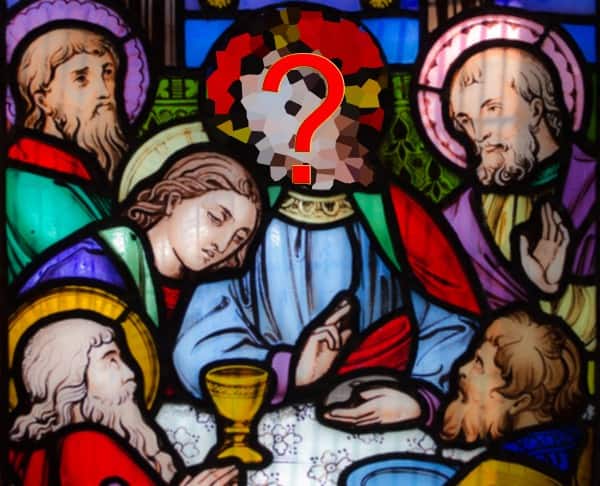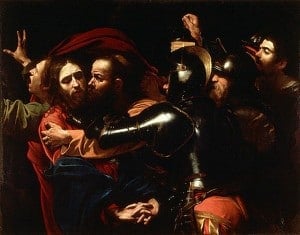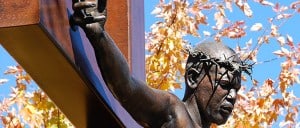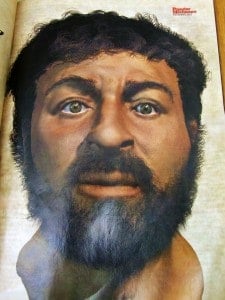I was getting out of the car during a late night errand to the local Target store in the Bronx and hustling before it closed for the night. As I was making my way across the parking lot, a departing customer caught sight of me from his car. He hit the brakes, rolled down the window, and gave me a shout with a big smile on his face: “JESUS!”
The driver was not cursing me. In fact, I knew exactly what he meant. The comparison has come more and more frequently. You see, for the past eighteen months, my hair has grown out beyond shoulder length, and I keep a full beard. No, the driver was not cursing me; he was remarking that I look like Jesus!
*****

The author: long hair, beard, etc…
The stranger from the Target parking lot was not the first to compare my physical appearance with the Son of God. It has come from my aunt, from a fellow Jesuit who had not seen me in a year, from a group of South African college students…too many to keep track of really.
“Has anyone ever told you that you look like Jesus??”
“We are all called to imitate Christ!” I reply, which is usually good for a laugh.
Occasionally I continue by saying, “You know, I see Jesus in your face, too.” (Cheesy, I know.) This tends to leave the person with a puzzled look on his or her face.
*****
These experiences have left me thinking: So what exactly does Jesus look like? Does Jesus look like a white man with a beard and long hair? How about an American man with German and Polish heritage in his early 30’s sporting ten-inch-long light brown hair with a full beard and brown eyes (i.e. me)?
If we rely on many of the conventional images of Jesus, the answer is probably “yes.”
I make no claims to be an art historian, but a cursory glance over European art history conveys a depiction of Jesus as a long-haired, bearded man in a manner that I might reasonably resemble. Let’s take a look at a few of the most famous ones.
- Leonardo da Vinci’s “Last Supper”: This might be one of the most lasting images of medieval European art, and da Vinci’s portrayal of Jesus is indicative of the day with long wavy hair flowing around Jesus’ white skinned face.
- Caravaggio’s “Taking of Christ”: The great Caravaggio from the height of the Renaissance in Italy gives Jesus a scraggly beard and wavy hair in his famous painting of Jesus’ arrest.
- El Greco’s “Christ Carrying the Cross”: This late Renaissance painter has a plethora of images of Jesus, and he continued in the tradition of long hair and beard on a pale white Jesus.
These paintings are world renowned for their beauty. But really – do they represent an accurate depiction of Jesus?
*****
This much we know: Jesus was a first-century Jew from Galilee. We have no definitive evidence of what he looked like during his years of ministry. In the Roman era, artistic portraits were rare and reserved for royalty like the Caesar, so they were non-existent for a poor vagabond prophet from Nazareth. Forget about photos, video clips or selfies: Jesus was a couple millennia too early. Our best accounts of Jesus (a few books we call the Gospels) fail to offer an accurate description of his physical appearance:
Jesus, tucking his long hair behind his ear, spoke to the crowd as he stroked his well-kept beard, “The reign of God is at hand.” (From: nowhere in the Bible)
Without a historical description of his appearance, artists have been left to their own devices in portraying Jesus in their work. It would be natural to turn to the earliest images of Jesus to try to get closest to an accurate portrait. Unfortunately, the oldest images of Jesus aren’t particularly helpful…nor are they quite as early as you might hope. The earliest surviving images date from the third century: imagine trying to draw a picture of one of your ancestors from the 1700’s!
I suppose this is what opened the door for European artists to make him look more like a fellow European. Perhaps there is a spiritual question at heart here. Do we want Jesus to look like us? Was this at the heart of European artists: a desire to identify with Jesus?
*****
When I was on a pilgrimage a few years ago, my group was reflecting on the wide international reach of the Catholic Church. Every day, we were encountering groups of pilgrims from every continent of the world. A member of my group remarked, “Isn’t it amazing that so many people are drawn to Jesus, even though he doesn’t look like them?”
I was taken aback by the comment. He might as well have been talking about us!
The conventional portrayal of a European Jesus has not always held the collective imagination of Christian communities. Artwork from across the world presents images of Jesus that contrast with the stereotypical image. Here are the links for a few striking examples [Note: a simple Google image search of “ethnicity + Jesus” will yield a plethora of results]
- African Gospel Art: The Gospel stories in this sample are set in an African village. The Last Supper scene has the Apostles dressed in colorful African garments, with a djembe tableside and Jesus blessing a large bowl for shared drinking.
- Swami Reproduction in India: In this image, Jesus is portrayed in a meditating pose while in communion with wild animals that are calm in the presence of Jesus.
- Native American Art: The Compassionate Christ in this painting has darker skin and the more defined facial features of a Native American, and he is clothed in traditional garments.
- African-American Slave: The campus of Regis University in Denver, Colorado, has a striking statue of the crucified Jesus with the features of an African-American slave.
These images reject the conventions of European artwork, but in doing so, they speak further to a desire to portray Jesus in a way that an individual can identify with: in these cases, for people from non-European ethnicities.
*****
Eschewing artistic renderings, historically motivated scholars have attempted to recreate an accurate image of Jesus, rooted in his historical context as a first-century Galilean Jew.
- Shroud of Turin: Some have turned to the Shroud of Turin, a disputed image of Jesus on a burial garment. The image of Jesus on the Shroud would confirm a longhaired, bearded man.
- Forensic Anthropology: Adopting a more technical approach, Richard Neave, a medical artist, and his research team recently made a publicized effort to create an accurate portrait of Jesus by employing “forensic anthropology” (fancy, right?). Neave and his team used excavated bones from the same time and region of Jesus’ life. Special computer programs and software were able to recreate muscles, skin, and facial features to overlay on the skulls. The image looks strikingly different from the conventional European Jesus.
From artistic renderings to scientific re-creations, there are so many images for the face of Jesus! What does Jesus really look like?
*****
For my part, I am grateful that we do not have a historical image of Jesus. Sure, a compelling portrait would make for good marketing (like your friend’s Che Guevara t-shirt). But some things might be better left for our imagination.
Without a historical image of Jesus, we can leave the appearance of Jesus to our own imagination. Surely God can work through our imagination without needing us to supply a historically accurate depiction of Jesus.
So there is no need to cling to a particular portrayal of Jesus. The growth of convention-breaking images of Jesus from African, Native American, Asian, and many other artists offer a variety of ways to imagine Jesus.
Let God be at work in your prayer and your imagination. If it helps your prayer to pray to an image of Jesus that looks more like you, God can work through that. If it helps your worship experience to pray before depictions of Jesus that match your ethnicity, God can work through that too.
The face of Jesus in the world today is not restricted to a white-skinned, longhaired, bearded man. The face of Jesus shines from every living person. Jesus, lest we forget, is not dead. He is alive, and he lives in every one of us.
So let me ask: has anyone ever told YOU that you look like Jesus?
— — — — —
Editor’s Note: the original of the cover image is available at Flickr by following this link.





